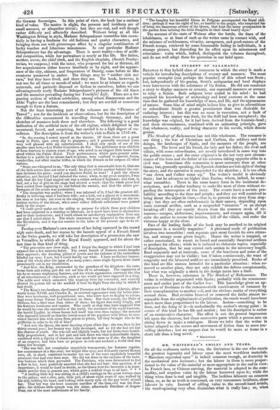THE STUDENT OF SALAMANCA BELONGS to that hybrid class of
romances in which the story is made a vehicle for introducing descriptions of scenery and manners. The most popular exemplar (not perhaps the founder) of this school was Scott ; but, independently of his genius, Scott's antiquarian and local displays were interwoven with the substance of his fiction. He did not construct a story to display manners or scenery, nor superadd manners or scenery to inlay a fiction. Both subjects were united in his mind : he had acquired his knowledge of archaeology and local customs at the same time that be gathered his knowledge of man, and life, and the appearances of nature. Some bias of mind might induce him to give to adventitious or subordinate details a greater prominence than was desirable for enduring interest ; but this was an error• in execution, not a fault of structure. The matter was fresh, for the field had been unexplored ; the knowledge was original, for it had been derived from the fountain-head; and these circumstances, combined with an animating principle, gave that wholeness, reality, and living character to his novels, which denote genius. The Student of Salamanca has not this wholeness. The romance is one thing ; the war of Christinos and Carlists, the soldiery and their doings, the landscapes of Spain, and the manners of the people, are another. The lover and his friend, the lady and her father, the rival and villain with some subordinates, are mostly introduced in some way into the public scenes ; and the story originates in the not very new circum- stance of the hero and the father of his mistress taking opposite sides in a civil war. Sometimes this connexion is more necessary than at other times; but, generally speaking, the Spanish sketches are lost sight of during the story, and the narrative is suspended for the sketches ; it is too often "one down and eother come up." The writer's model is obviously Scott ; hut he advances no higher than Barium; whom, indeed, he some- what resembles. There is the same heavy force in the incidental de- scriptions and a similar tendency to make the most of them without re- garding die interruption of the story. The events have a certain pro- bability according to the time and people ; and they are well contrived to bring about the object in view,—that is, to prevent the story from stop- ping : but they are often melodramatic in their nature, depending upon some external artifice, such as a suspended "situation" or an abrupt breaking off: they are mostly drawn from the common stook of ro- mances—escapes, abductions, imprisonments, and escapes again' till it suits the author to rescue the heroine, kill off the villain, and make the virtuous happy at the close.
Part of the leading faults of the book may be ascribed to its original
appearance in a monthly magazine.* A piecemeal mode of publication involves two necessities : each separate part must furnish its own stimu- lus, and occupy some given length. Hence the writer is tempted, or rather constrained, to resort to forced and essentially theatrical artifices to produce his effects while he is induced to elaborate topics, especially of description, that he may extend each section to the necessary length. Read separately and at intervals, some of the heaviness and some of the exaggeration may not be visible ; but if taken continuously, the want of congruity and the laboured artifices are immediately perceived. Books of this kind are like statues intended for a particular situation : when re- moved to another place, they not only exhibit the defects conspicuously, but what was originally a merit in the design turns into a fault. There is, however, substance in The Student of Salamanca. The
writer is evidently acquainted with Spain ; probably with the commence- ment and earlier part of the Carliat war. This knowledge gives an ap- pearance of freshness to the common-stock contrivances of romance by their transplantation to another soil, and the obvious reality of everything around them. Had revision lessened or removed the faults almost in- separable from the originalmode of publication, the result would have been much more than proportioned to the labour. Action—something to be done, and the doing of it—is undoubtedly the anchor's strong point : in scenes of this kind he has life and motion ; but his description is rather of an enumerative character. The effect is not the general impression left upon the observer, but those successive parts which a person sees on sitting down to make a catalogue. Hence we infer that the writer is better adapted to the scenes and movement of fiction than to mere tra- velling sketches; but we suspect that he would be more at home in a short tale than a long novel.
• Blackwood.


























 Previous page
Previous page